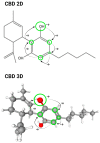An Overview of Cannabidiol as a Multifunctional Drug: Pharmacokinetics and Cellular Effects
- PMID: 38257386
- PMCID: PMC10818442
- DOI: 10.3390/molecules29020473
An Overview of Cannabidiol as a Multifunctional Drug: Pharmacokinetics and Cellular Effects
Abstract
Cannabidiol (CBD), a non-psychoactive compound derived from Cannabis Sativa, has garnered increasing attention for its diverse therapeutic potential. This comprehensive review delves into the complex pharmacokinetics of CBD, including factors such as bioavailability, distribution, safety profile, and dosage recommendations, which contribute to the compound's pharmacological profile. CBD's role as a pharmacological inhibitor is explored, encompassing interactions with the endocannabinoid system and ion channels. The compound's anti-inflammatory effects, influencing the Interferon-beta and NF-κB, position it as a versatile candidate for immune system regulation and interventions in inflammatory processes. The historical context of Cannabis Sativa's use for recreational and medicinal purposes adds depth to the discussion, emphasizing CBD's emergence as a pivotal phytocannabinoid. As research continues, CBD's integration into clinical practice holds promise for revolutionizing treatment approaches and enhancing patient outcomes. The evolution in CBD research encourages ongoing exploration, offering the prospect of unlocking new therapeutic utility.
Keywords: CBD; anti-inflammatory; antioxidant; cannabidiol; cellular effects; pharmacokinetics.
Conflict of interest statement
Antonio Abbate received research grant funding and has served as a paid scientific advisor to Implicit Biosciences, Kiniksa, Lilly, Merck, Novartis, Novo Nordisk, Olatec, R-Pharm, Serpin Pharma, and Swedish Orphan Biovitrum. Stefano Toldo has served as a paid scientific advisor to Cardiol Therapeutics and Novo Nordisk and received research grant funding from Kiniksa, Olatec, Serpin Pharma, and Cardiol Therapeutics.
Figures





References
-
- Rock E.M., Parker L.A. Constituents of Cannabis Sativa. In: Murillo-Rodriguez E., Pandi-Perumal S.R., Monti J.M., editors. Cannabinoids and Neuropsychiatric Disorders. Springer International Publishing; Cham, Switzerland: 2021. pp. 1–13. Advances in Experimental Medicine and Biology.
Publication types
MeSH terms
Substances
LinkOut - more resources
Full Text Sources
Research Materials

